 | |
| Authors | Geoffry O. Dale |
|---|---|
| First published | 1980 |
Inferno is an adventure for fantasy role-playing games published by Judges Guild in 1980.
 | |
| Authors | Geoffry O. Dale |
|---|---|
| First published | 1980 |
Inferno is an adventure for fantasy role-playing games published by Judges Guild in 1980.
Inferno is an adventure scenario intended for player characters of levels 10-14, which takes place in the first four circles of Hell as detailed in the works of Dante, with statistics for new devils. [1] This module adapts the encounters from the first four rings of the Inferno . [2]
Inferno was written by Geoffry O. Dale, with illustrations by Kevin Siembieda, and was published by Judges Guild in 1980 as a 64-page book. [1]
This adventure was planned as the first half of a set and describes only the first four circles of the inferno. The second part of the set was planned to be released in late 1980. The introduction of the module credits Dante and notes that the Archdevils in the original Monster Manual were placed in the incorrect circles of Hell. [3] The sequels that were planned to detail the lower levels were never published by Judges Guild. [1]
In 2014, Spellbook Games released Inferno: Journey through Maleboge, by Paul Elkmann and Geoffrey O. Dale, a three book set that revised and completed the original Judges Guild adventure. [4] This revision includes all nine circles as described by Dante.[ citation needed ]
Ron Shigeta reviewed the adventure in The Space Gamer No. 31. [2] He commented that this adventure "is for those that have gotten cursed scrolls saying, "Go to Hell!!" or owe a Geas to some Lawful Good cleric. Hell is everything it's cracked up to be. Not just anybody can dash in and out of this place. As a matter of fact, it would be the achievement of a character's career to get out alive, as it should be. Everything is covered, from Tiamat's cave to the palace of Minos – and nothing is easy; both new and old Devils and monsters abound here." [2] He continued: "But not everything is as it should be. Minos' Palace has 13 rooms and Tiamat's cave has four paragraphs, where it should have a book of its own. Often a description of some new magical item will take up more room than the overall description of the level it's on. Usually the only major encounters are those on the road through, leaving the rest of the circle one big random encounter area." [2] Shigeta concluded the review by saying, "I bought Inferno because I wanted the plane of 9 Hells in my campaign and didn't have the time to do it myself. Anybody who wants to spend a few weeks on it can probably do as well or better, and with the gaps in Book 1, I feel little confidence in the forthcoming book 2, which contains the remaining five levels, the infernal City of Dis, all the Monster Manual Arch-Devils, and the only way off the plane .... Perhaps Mr. O'Dale should be playing Napoleon instead." [2]
Inferno was reviewed in Dragon #44 (December 1980) by William Fawcett. He commented that "This is one of the more expensive and longest modules offered by Judges Guild. It is a mixed offering with some excellent points and some potential problems. Many DMs will like this module just because it is perhaps the one situation where they can validly play with Asmodeus as a wandering monster!" [3] Regarding the commentary on TSR's placement of the archdevils, he stated that "Actually there is support for both placements; the argument harkens back to the days of the “angels on a pin” discussions. Depending on their sources, both authors have them placed correctly (or relatively, incorrectly). In any case this is of little importance to the play as most characters will be reluctant to face any of the Archdevils anyhow." [3] Fawcett added: "Obviously, this is a very high-level dungeon. A party of no fewer than eight members and averaging no less than 10th to 14th level is suggested. Even for these levels, this is a very deadly place. This puts a strain on the judge; there is a fine line between playing this module well and playing it either so deadly as to be discouraging or crossing over into Monty Haul dungeoning. [...] This can lead to a party that is terribly over-encumbered with new major magic items." [3] He continued "Another problem inherent with playing characters and monsters who are this high in levels is that it takes a long time to resolve most melees. Either the characters have a lot of hit points or the more complicated magics take longer to roll up and compute. Several new spells are also suggested for use in the module, many of which would unbalance a campaign when (or if) the characters return. Even with these problems this module can be a real experience if played with a capable DM. There are some excellent descriptions in the early sections that set the mood beautifully for the players. The DM is further aided by suggestions throughout the book on how to play certain situations. These, for the most part, are quite useful. The module handles encountering and generating high-level monsters very well." [3] Fawcett concluded his review by saying, "If you are looking for something that will challenge players who have characters grown to great heights or are looking for a suitable ground to play high-level characters as a change, this is an excellent choice. This is definitely not a module for a new DM to attempt, but correctly run it offers an unusual challenge." [3]

Tomb of Horrors is an adventure module written by Gary Gygax for the Dungeons & Dragons (D&D) role-playing game. It was originally written for and used at the 1975 Origins 1 convention. Gygax designed the adventure both to challenge the skill of expert players in his own campaign and to test players who boasted of having mighty player characters able to best any challenge. The module, coded S1, was the first in the S-series, or special series of modules. Several versions of the adventure have been published, the first in 1978, and the most recent, for the fifth edition of D&D, in 2017 as one of the included adventures in Tales from the Yawning Portal. The module also served as the basis for a novel published in 2002.

The Lost Island of Castanamir (C3) is an adventure module written by Ken Rolston for the first edition of the Advanced Dungeons & Dragons fantasy roleplaying game. The adventure was published in 1984 by TSR. As part of the C(ompetition)-series of modules The Lost Island of Castanamir contains material first used as a tournament adventure. The adventure is intended for five to eight characters of level 1-4.
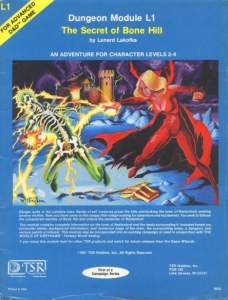
The Secret of Bone Hill is an adventure module written by Lenard Lakofka for the first edition of Advanced Dungeons & Dragons and published by TSR in 1981. It is designed for novice and intermediate players with characters of levels 2-4. The module received mixed reviews from critics.

In Search of the Unknown is a module for the Dungeons & Dragons roleplaying game, designed for use with the Basic Set of rules. It was written by game designer Mike Carr and was first published in 1978 by TSR, Inc. The module details a hidden complex known as the Caverns of Quasqueton. Reviewers considered it a good quality introduction to the game that was written in the so-called dungeon crawl style, where the primary goal of the players is the exploration of a dangerous labyrinth to battle monsters and obtain treasure.

Tiamat is a supremely strong and powerful 5-headed draconic goddess in the Dungeons & Dragons role-playing game. The name is taken from Tiamat, a goddess in ancient Mesopotamian mythology. She is the queen and mother of evil dragons and a member of the default pantheon of Dungeons & Dragons gods. Her symbol is a five-headed dragon.
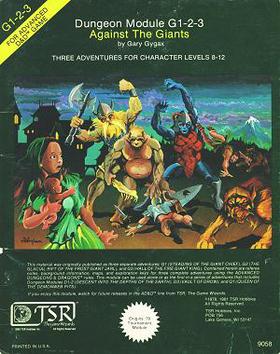
Against the Giants is an adventure module written by Gary Gygax and published by TSR in 1981 for the Dungeons & Dragons fantasy role-playing game. It combines the G series of modules previously published in 1978: Steading of the Hill Giant Chief, Glacial Rift of the Frost Giant Jarl, and Hall of the Fire Giant King. All three were produced for use with the 1st edition Advanced Dungeons & Dragons rules. In 1999, to recognize the 25th anniversary of TSR, the company released an updated version, Against the Giants: The Liberation of Geoff. Later in 1999, Wizards of the Coast published a novelization of Against the Giants by Ru Emerson.
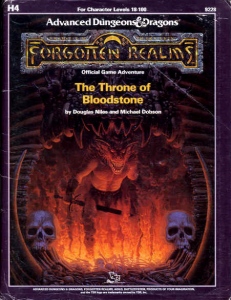
H4 - The Throne of Bloodstone is an Official Game Adventure or "module" for the Advanced Dungeons & Dragons fantasy role-playing game.

The Gem and the Staff, by John and Laurie Van De Graaf, is an adventure module for the Dungeons & DragonsExpert Set. Rather than being a typical group adventure, The Gem and the Staff was designed for head-to-head tournament-style play, with players separately playing the same adventure and competing against each other for points earned by accomplishing certain goals. The adventure is only playable with one dungeon master (DM) and one player.
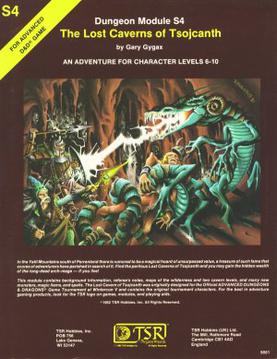
The Lost Caverns of Tsojcanth is an adventure module for the Dungeons & Dragons fantasy role-playing game. It was written by Gary Gygax and published by TSR in 1982 for the first edition Advanced Dungeons & Dragons (AD&D) rules. The 64-page adventure bears the code "S4" and is set in the Greyhawk campaign setting. It is divided into two parts, a 32-page adventure, and a 32-page booklet of monsters and magic items. The plot involves the player characters investigating rumors of lost treasure. After traversing a wilderness and two levels of dungeons, the players face Drelnza, the vampiric daughter of long-deceased archmage Iggwilv.
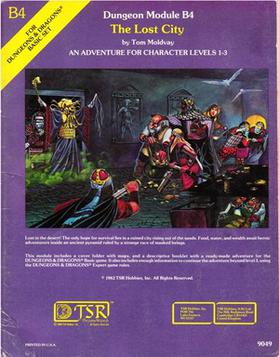
The Lost City (B4) is a Dungeons & Dragons adventure module by Tom Moldvay. It was first published by TSR in 1982 and was designed as a stand-alone adventure for use with the Dungeons & Dragons Basic Set. The working title for the module was "The Lost City of Cynidicea". Moldvay designed the module as a low-level scenario to give novice Dungeon Masters experience in fleshing out adventures such that it is only partially complete. The plot involves the player characters discovering a ruined subterranean city slowly rising out of the sands. The adventure is set inside a huge step pyramid, with the lower pyramid only sketched out and the city itself described with a list of the major areas and a map. The adventure's main villain is Zargon, a giant one-eyed monster and his minions. The entire double pyramid, not including the city, contains over 100 rooms.

The Sentinel is an adventure module for the Dungeons & Dragons fantasy role-playing game, set in World of Greyhawk campaign setting.

The Gauntlet is an adventure module for the Dungeons & Dragons fantasy role-playing game, set in the World of Greyhawk campaign setting.

Lankhmar – City of Adventure is an accessory for the Dungeons & Dragons fantasy role-playing game, first published by TSR in 1985.
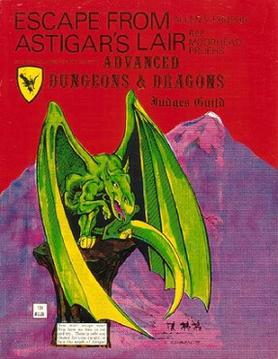
Escape from Astigar's Lair is an adventure for fantasy role-playing games published by Judges Guild in 1980.

Portals of Torsh is a supplement for fantasy role-playing games published by Judges Guild in 1980.
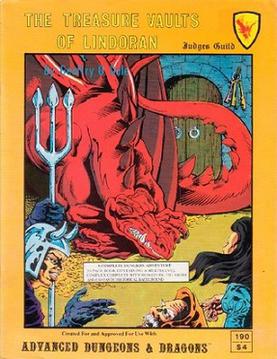
The Treasure Vaults of Lindoran is an adventure for fantasy role-playing games published by Judges Guild in 1980.

Zienteck is an adventure for fantasy role-playing games published by Judges Guild in 1981.
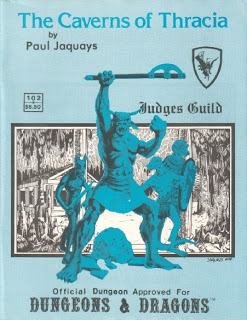
The Caverns of Thracia is an adventure for fantasy role-playing games published by Judges Guild in 1979. Written by Jennell Jaquays, it was compatible with Dungeons & Dragons. A revised edition—compatible with Dungeons & Dragons 3.5 edition—was published in 2004.
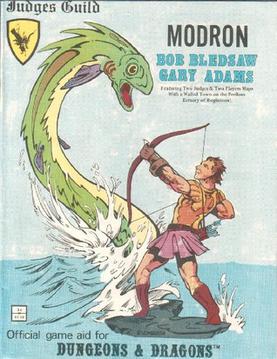
Modron is an adventure for fantasy role-playing games published by Judges Guild in 1978.
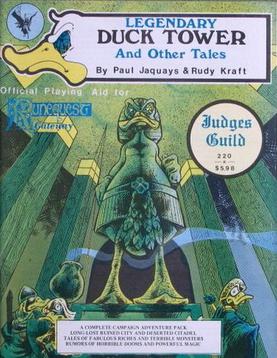
Legendary Duck Tower is a 1980 fantasy role-playing game adventure published by Judges Guild.